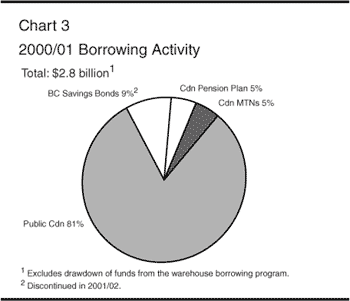
|
PROVINCIAL FINANCING The provincial government and its Crown corporations and agencies borrow funds to finance operations and capital projects. Borrowing for operations is required when revenues fall short of expenditures and to meet other cash requirements such as loans and investments. Borrowing for capital projects finances the building of schools, hospitals, roads and other infrastructure. These investments provide essential services to benefit current and future generations of British Columbians. The province’s debt is reported using two basic classifications — taxpayer-supported debt and self-supported debt. Taxpayer-supported debt includes the direct debt of government and the debt of Crown corporations and agencies that require an operating or debt service subsidy from the provincial government. Self-supported debt includes the debt of commercial Crown corporations and agencies, which fully fund their operations and debt from revenue generated through the sale of services at commercial rates, and debt of the warehouse borrowing program. Taxpayer-supported debt is a measure often used by investors and credit rating agencies when assessing a province’s investment quality. The ratio of a province’s taxpayer-supported debt relative to its current dollar gross domestic product (GDP) highlights the ability of a province to manage its debt load. British Columbia’s taxpayer-supported debt ratio is one of the lowest in Canada, and this translates into a strong credit rating and relatively low debt servicing costs. Chart 1 shows that, according to the Moody’s Investors Service, British Columbia had the second lowest taxpayer-supported debt-to-GDP ratio of all provinces at the end of 2000/01.
Borrowing Process Almost all Crown corporation and agency borrowing is done through the fiscal agency borrowing program. Under this program, the provincial government borrows directly in financial markets and re-lends the funds to Crown corporations and agencies. Borrowing and financing costs remain the responsibility of the Crown corporation or agency. The primary advantage of the fiscal agency program is that it provides lower-cost financing to Crown corporations due to the province’s strong credit rating and its ability to borrow at lower interest rates. Borrowing Sources Provincial borrowing has come from a variety of sources, including public financial markets in Canada, the United States, Europe and Asia; the Canada Pension Plan Investment Fund; private institutional lenders; and provincial trusteed funds. Chart 2 shows that over the last 11 years, borrowing sources have shifted from private placements, such as the provincial trusteed funds and Canada Pension Plan, towards public markets, particularly in Canada (e.g. BC Savings Bonds and Canadian medium-term notes) and Europe.
Effective in 2001/02, the BC Savings Bonds program has been discontinued as it is more economical to borrow in other public markets. Diversification of borrowing sources is a key factor in lowering financing costs and maintaining investor demand for British Columbia bonds and notes. A broad investor base is important given increased competition for funding. 2000/01 Financing The province raised all of its $2.8 billion financial requirements from domestic markets, including $249 million in BC Savings Bonds and $149 million from the Canada Pension Plan (see Chart 3). 2001/02 Financing In 2001/02, net new financing requirements for the provincial government and its Crown corporations and agencies are estimated at $5.2 billion ($5.7 billion including the forecast allowance). Gross requirements totalling $5.9 billion for the government and Crown corporations and agencies will be partially offset by a $712-million drawdown from funds previously borrowed through the warehouse borrowing program. Borrowed funds will be used to refinance maturing debt and to partially finance capital and currently-forecast operating requirements of the government and its Crown corporations and agencies. The remainder of capital and operating requirements will be financed through internal sources of funds, such as surplus earnings of commercial Crown corporations, and surplus cash balances and borrowings at the end of 2000/01. The 2001/02 financing requirements will be met through new borrowing in the domestic and international markets. The province’s strategy will be to borrow in a variety of markets, in both fixed and floating rate form.
|


